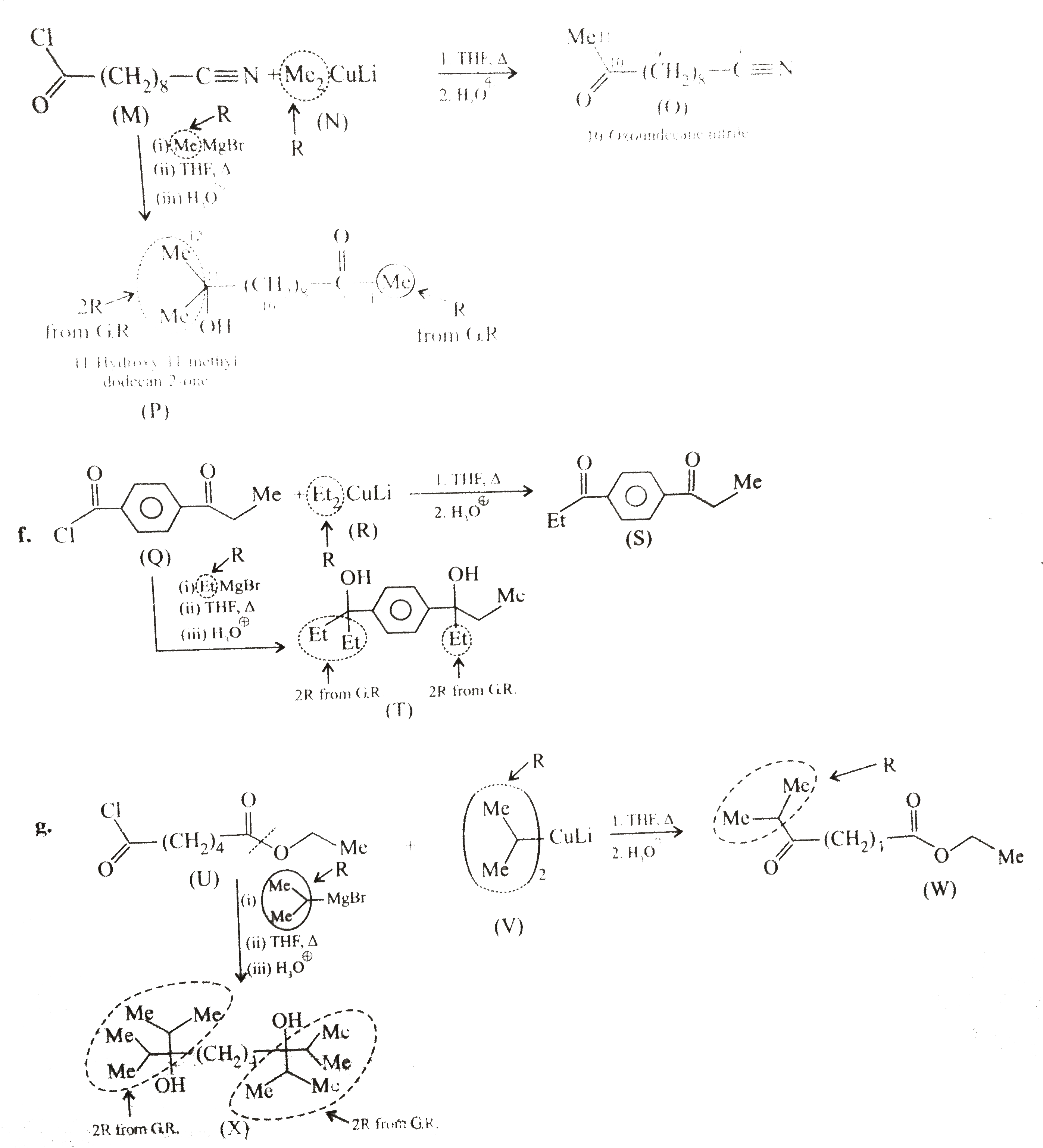Concrete is produced form a mixture of cement, water and small stones. Small amount of gypsum, is added in coment production to impove the subsequent hardening of concrete. The elevated temperature during the production of cement may lead to the formation of unwanted hemihydrate according to reaction.
The
are and , respectively. The respective values of their standard entropies are and . The values of bar .
Answer the following questions on the basis of above information.
The equilibrium pressure of water vapour in closed vessel containing and at (Antilog is
(a)
(b) is a cyclic ester, called lactone. The ester reacts with of to give alcohol. (Two groups come from the )

( c) is a cyclic anhydride. The anhydride reacts with of to give alcohol (two groups come from the ) Nucleophilic addition reaction is favoured by the electron-withdrawing group and disfavoured by electron-donating group . The cleavage of ring takes place from the side not containing the (Me group).

(d) is a cyclic amide, called lactam. The amide reacts with of to give ketone (one comes from the ).

In and , less reactive (dialkyl lithium cuprate) reacts only with more reactive
group, but more reactive reacts with both and groups. Two moles of reacts with group to give alcohol (two groups come from the ) , but with group, the gives ketone (one group comes from ).
(e) 
Topper's Solved these Questions
- GRIGNARD REAGENTS AND ORGANOMETALLIC REAGENTSBOOK - CENGAGE CHEMISTRY ENGLISHCHAPTER - GRIGNARD REAGENTS AND ORGANOMETALLIC REAGENTSEXERCISE - Solved Examples
15 Videos
- GRIGNARD REAGENTS AND ORGANOMETALLIC REAGENTSBOOK - CENGAGE CHEMISTRY ENGLISHCHAPTER - GRIGNARD REAGENTS AND ORGANOMETALLIC REAGENTSEXERCISE - Exercises (Subjective )
17 Videos
- GENERAL PRINCIPLES AND PROCESS OF ISOLATION OF ELEMENTSBOOK - CENGAGE CHEMISTRY ENGLISHCHAPTER - GENERAL PRINCIPLES AND PROCESS OF ISOLATION OF ELEMENTSEXERCISE - Archives (Subjective)
14 Videos
- NCERT BASED EXERCISEBOOK - CENGAGE CHEMISTRY ENGLISHCHAPTER - NCERT BASED EXERCISEEXERCISE - Nuclear Chemistry (NCERT Exercise)
29 Videos
Similar Questions
Concrete is produced form a mixture of cement, water and small stones. Small amount of gypsum, CaSO4.2H2O is added in coment production to impove the subsequent hardening of concrete. The elevated temperature during the production of cement may lead to the formation of unwanted hemihydrate CaSO412H2O according to reaction.
CaSO42H2O(s)→CaSO412H2O(s)+32H2O(g)
The ΔfHΘofCaSO2.2H2O(s),CaSO412H2O(s),H2O(g)
are −2021.0kJmol−1,−1575.0kJmol−1 and −241.8kJmol−1, respectively. The respective values of their standard entropies are 194.0,130.0 and 188.0JK−1mol−1 at 298K. The values of R=8.314JK−1mol−1=0.0831L barmol−1K−1.
Answer the following questions on the basis of above information.
The value of equilibrium for reaction is
View SolutionConcrete is produced form a mixture of cement, water and small stones. Small amount of gypsum, CaSO4.2H2O is added in coment production to impove the subsequent hardening of concrete. The elevated temperature during the production of cement may lead to the formation of unwanted hemihydrate CaSO412H2O according to reaction.
CaSO42H2O(s)→CaSO412H2O(s)+32H2O(g)
The ΔfHΘofCaSO2.2H2O(s),CaSO412H2O(s),H2O(g)
are −2021.0kJmol−1,−1575.0kJmol−1 and −241.8kJmol−1, respectively. The respective values of their standard entropies are 194.0,130.0 and 188.0JK−1mol−1. The values of R=8.314JK−1mol−1=0.0831L bar mol−1K−1.
Answer the following questions on the basis of above information.
The formation of CaSO412H2Oat 298K is
View SolutionConcrete is produced form a mixture of cement, water and small stones. Small amount of gypsum, CaSO4.2H2O is added in coment production to impove the subsequent hardening of concrete. The elevated temperature during the production of cement may lead to the formation of unwanted hemihydrate CaSO412H2O according to reaction.
CaSO42H2O(s)→CaSO412H2O(s)+32H2O(g)
The ΔfHΘofCaSO2.2H2O(s),CaSO412H2O(s),H2O(g)
are −2021.0kJmol−1,−1575.0kJmol−1 and −241.8kJmol−1, respectively. The respective values of their standard entropies are 194.0,130.0 and 188.0JK−1mol−1. The values of R=8.314JK−1mol−1=0.0831L bar mol−1K−1.
Answer the following questions on the basis of above information.
The value of ΔGΘ for the reaction at 298K is
View SolutionConcrete is produced form a mixture of cement, water and small stones. Small amount of gypsum, CaSO4.2H2O is added in cement production to improve the subsequent hardening of concrete. The elevated temperature during the production of cement may lead to the formation of unwanted hemihydrate CaSO412H2O according to reaction.
CaSO42H2O(s)→CaSO412H2O(s)+32H2O(g)
The ΔfHΘofCaSO2.2H2O(s),CaSO412H2O(s),H2O(g)
are −2021.0kJmol−1,−1575.0kJmol−1 and −241.8kJmol−1, respectively. The respective values of their standard entropies are 194.0,130.0 and 188.0JK−1mol−1. The values of R=8.314JK−1mol−1=0.0831L bar mol−1K−1.
Answer the following questions on the basis of above information.
Heat change occurring during conversion of 1kg of CaSO4.2H2O(s) (molar mass 172gmol−1) of CaSO412H2O(s) is equal to
View SolutionCaSO3↓+H2SO4→CaSO4+SO2↑+H2O
View SolutionCaSO3↓+H2SO4→CaSO4+SO2↑+H2O
View SolutionIn the reaction.
H2S+H2O2→S+2H2O describes
1. Acidic nature of H2O2
2. Reducing nature of H2O2
3. Alkaline nature of H2O2
4. Oxidizing nature of H2O2
View SolutionThe equilibrium constant for the reaction CaSO4.H2O(s)⇔CaSO4.3H2O(s)+2H2O(g) is equal to
View SolutionCa(OH)2+SO2→CaSO3⏐↓+H2O
View SolutionCa(OH)2+SO2→CaSO3⏐↓+H2O
View Solution
